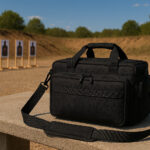![]()
Best LPVO
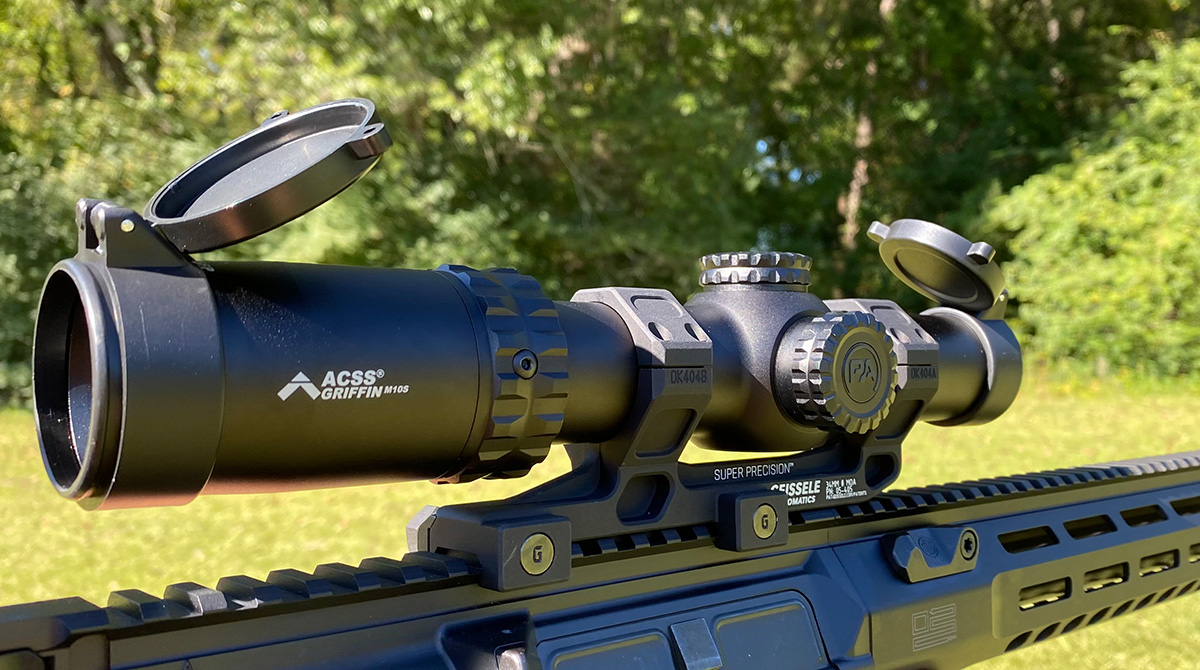
LPVO’s (Low Power Variable Optics) have been on the rise in popularity for years now. There are so many great LPVO options today that it is almost overwhelming to choose.
This article will show you some of the best LPVO options and why those options are the best LPVO for the money.
Variable Options
The variable options on LPVO’s vary wildly, but there are a few options you’ll often see in your hunt for an LPVO.
Some of those options include:
- 1-6x24mm
- 1-8x24mm
- 1-10x24mm
These options are extremely popular because they provide decent magnification and allow you to acquire your target and make accurate shots quickly.
EOTECH does offer the Vudu optic in an impressive 5-25x50mm, but it comes at a price.
What is an LPVO?
An LPVO is a variable power scope that doesn’t typically offer extremely high levels of magnification but the eye relief (layman’s terms: how easy the scope is easy to see out of) is much better than that of a high power magnification scope.
An LPVO is a Low Power Variable Optic, a type of rifle scope that starts with a true 1x magnification and increases to 4x, 6x, 8x, and some as high as 10x. It provides greater eye relief than standard scopes and is typically used on AR-15s or other similar platforms, as well as primary battle rifles.
These scopes are popular for modern sporting rifles, bolt action rifles, and even on .22 LR rifles, as they are easy to use, powerful, and budget-friendly.
Why LPVO?
LPVO’s are excellent optics for people looking for the quick and easy eye relief of a red dot but the flexibility of a variable power scope.
LPVOs are a great investment option for 2023 due to their versatility and durability.
They are an excellent optic for modern sporting rifles, bolt action rifles, and even .22 LR rifles, providing near and far capability with impressive magnification in a small housing.
Additionally, their slight magnification allows for more reach and fast target acquisition, making them ideal for 3-gun competitors and hunters alike, who may be shooting at a variety of distances.
On top of that, LPVOs are also built for toughness, able to take a significant hit and keep operating.
All of these features make LPVOs an investment that can be utilized for a variety of needs and will last for years to come.
If you have a rifle that shoots an intermediate distance round like the 5.56mm an LPVO is an excellent optic option.
Primary Arms SLx 1-6x24mm
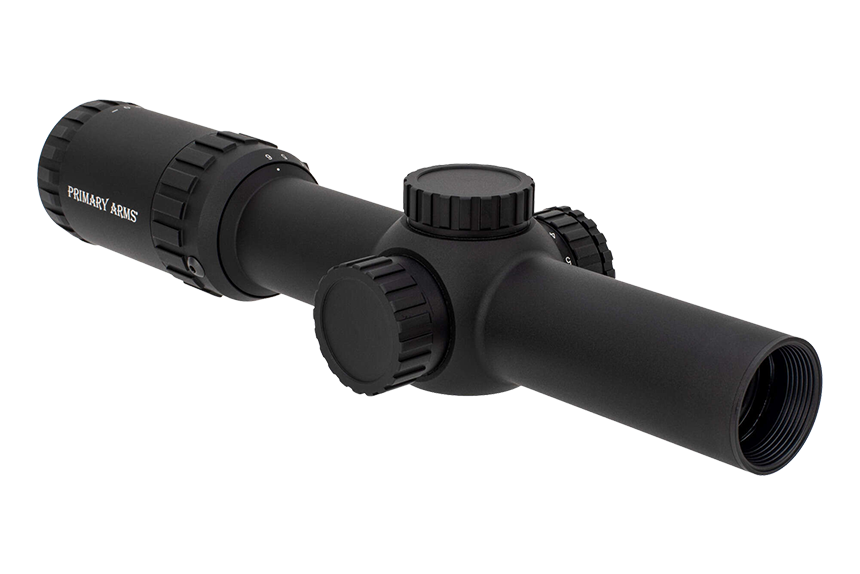
Primary Arms SLx 1-6x24mm
Primary Arms makes one of the best affordable LPVO’s on the market today. The SLx series provides a list of features that, for the price, is hard to beat.
The Primary Arms SLx LPVO features a 1X – 6X magnification and an illuminated reticle. The SLx 1-6x24mm comes in at just 16.9oz.
I’ve had one of these for some time, and it works great. It is a hard-to-beat optic for the money.
Monstrum Spectre 1-6×24
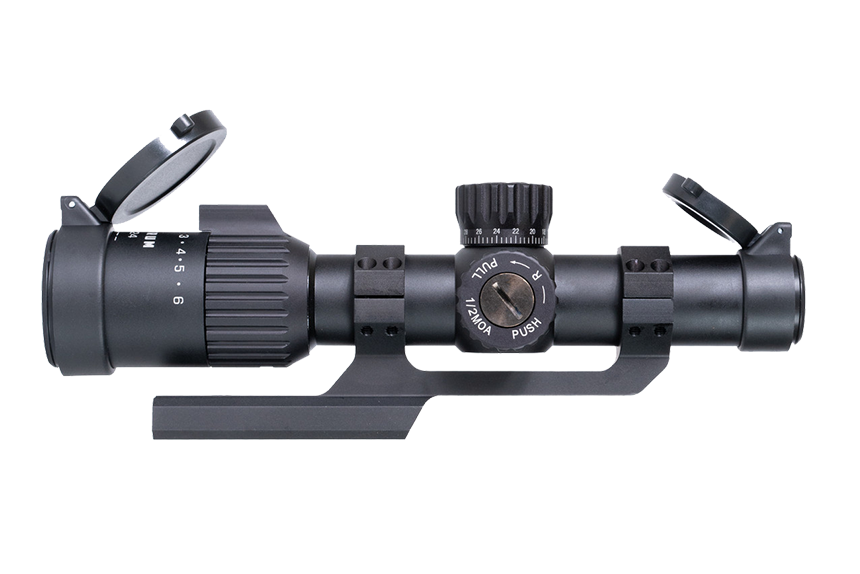
Monstrum Spectre 1-6×24
One of the lesser-known LPVO brands is Monstrum and I’ve been using one for a few months now and the Spectre 1-6×24.
The Spectre is sealed and nitrogen charged for resistance to fog and water and does an excellent job at not fogging.
One of the great things about the Monstrum Spectre 1-6×24 is that it comes with an already included mount. The mount isn’t the lightest, but for the fantastic price point, it’s hard to complain about an optic mount combo for this price.
EOTECH Vudu 1-6×24
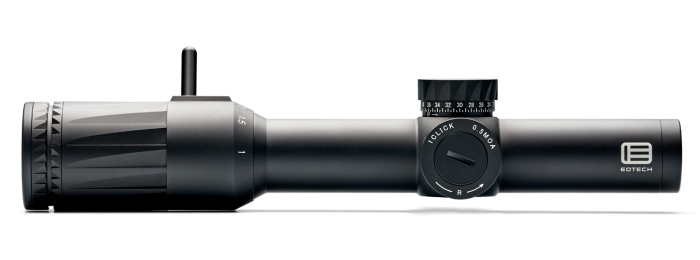
EOTECH Vudu 1-6×24
Moving on up in cost and overall quality, the EOTECH Vudu line is a high-end, high-performance LPVO.
The Vudu is one of the newer LPVO’s on the market and has made a splash, but who wouldn’t expect high quality from the worlds leading provider of holographic weapon systems?
While this optic is highly durable and the eye relief and sight picture are fantastic, it has a $1,000+ price point.
That might be a huge turn-off for some, but it is a solid optic, and if you have the budget for it, consider it.
Vortex Viper PST

Vortex Viper PST Gen II 1-6×24
The Vortex Viper PST is one of the best mid-range LPVO’s and is one I highly recommend if you have roughly a $500 budget.
The Viper carries Vortex’s fantastic transferable lifetime warranty. The Viper has multi-coated lenses and is built with aircraft-grade aluminum.
I’ve always been a big fan of Vortex because they make quality optics with good eye relief. The Viper comes in at 22.7 ounces, so you won’t be adding a ton of weight to your rifle.
The Viper also does not come with an LPVO mount, so you will need to purchase one for the Viper.
What factors do you need to consider when choosing a LPVO for your rifle?
Features and specifications
When choosing an LPVO for your rifle, it is important to consider a few key features that make this optic unique and best suited for specific applications. The most important factor to consider when selecting an LPVO is the magnification range. Typically, LPVOs start at 1.0X to 1.5X and can go up to 10X or even 12X. Additionally, LPVOs provide better eye relief than regular scopes and provide shooters with both near and far capability. Other features to consider when purchasing an LPVO include budget, focusing, illumination and more. Additionally, LPVOs are usually smaller and lighter than other optics, making them a great choice for modern sporting rifles, bolt action rifles, and even on .22 LR rifles. Ultimately, an LPVO is an excellent optic that is easy to use, powerful enough to target distant targets, and cost-effective.
Price and budget
When choosing a LPVO for a rifle, price and budget should be one of the biggest considerations. Low budget LPVOs will range from 100-300 dollars, and mid-range LPVOs will cost around $500. High-end LPVOs can cost anywhere from $500 to $5000. The more expensive LPVOs will have more features and a better build quality than the cheaper models. Mid-tier LPVOs usually have all the features you want for a reasonable price. Additionally, many LPVOs come with a manufacturer’s warranty, such as the well-known VIP Warranty from Vortex Optics, which allows you to replace your LPVO even if it breaks. Ultimately, it comes down to the specific needs of the shooter and how much they are willing to invest.
Field of view and visibility
Field of view and visibility are two of the most important factors to consider when choosing a LPVO for a rifle. With a LPVO, the shooter has access to a wide field of view, which allows them to quickly acquire and engage targets. Additionally, LPVOs are equipped with a red dot illumination feature, allowing for visibility even in low light conditions. This ensures that the shooter is always able to identify their target, regardless of the environmental conditions. The combination of wide field of view and visibility makes LPVOs an ideal choice for shooters looking for a versatile, reliable, and accurate optic.
Accuracy and precision
Accuracy and precision are both important when choosing a LPVO for a rifle. A LPVO is designed to give you the best accuracy and precision at mid-range and long-range distances, with long-range being up to 800 yards or more. An LPVO gives you the option to quickly switch between magnification settings, so you can quickly adjust your shot to hit your target. Accuracy and precision are also important to ensure that you’re using the right scope for your rifle and application. LPVOs are designed to withstand some external wear and tear, and also have a wide eye relief window so that you can acquire a target quickly and accurately. Accuracy and precision are also important when dealing with a limited aperture size, since it’s important to get a clear image of the target in order to hit it. By choosing an LPVO of the right magnification and aperture size, you can ensure that your shots are accurate and precise even at extended distances.
Reticle design and options
LPVOs require optics companies to produce reticles that are capable of both close and mid to long range shooting.
The reticle design used often depends on the magnification of the scope, with higher magnification requiring a more complicated system to allow for bullet drop and windage. Generally, these reticles are triangular in design and measure windage in either MILs or MOA. For close range shooting, a daylight bright illuminated reticle is necessary, and while budget LPVOs often fail to provide this feature, it is worth investing in for combative roles.
Thirdly, BDC (bullet drop compensating) reticles are available for specific calibers and barrel lengths, but may be less accurate with any variation. In conclusion, when choosing an LPVO, the reticle type and options are an important consideration for the performance of the scope.
Illumination technology
The importance of illumination technology when choosing a LPVO for a rifle cannot be overstated. Illumination technology is the difference between being able to quickly acquire your target in low light conditions and struggling to make out your target.
With an illuminated reticle, the shooter is able to quickly and accurately acquire their target in any light condition, allowing them to take the most accurate shot possible. Additionally, with an illuminated reticle, the shooter can easily adjust the magnification to the right amount for the situation, such as lowering it for close quarters or increasing it for longer range shots.
With all of these features, it is easy to see why LPVOs with illumination technology are so popular among shooters.
Turret controls and setup
When selecting a LPVO for a rifle’s turret controls and setup, it’s important to consider both the type of turrets and the setup needed for your rifle. Capped or pull-to-turn turrets are the most common type of turrets for LPVO scopes, as they are designed for holding for shooting solutions and not for dialing.
Capped turrets are covered for added protection and are better for quickly adjusting the scope in the field. Pull-to-turn turrets are more precise, as they can be adjusted in smaller increments and require less force to make adjustments. Additionally, LPVO scopes typically come with either first-plane or second-plane reticles, with the former featuring a bright aiming point at lower magnifications and the latter with partial illumination.
Both types of reticles can be useful for taking quick shots, but first-plane reticles are better for more precise aiming.
Finally, it’s important to consider the scope’s illumination, as some do not offer illumination at all, while others may feature a bright aiming point at lower magnifications. Therefore, based on your shooting needs, it’s important to carefully consider the type of turrets, reticles, and illumination the scope offers when selecting a LPVO for a rifle’s turret controls and setup.
Eye relief and length of eyerelief
The choice of a Low Power Variable Optic (LPVO) for a rifle is largely dependent on the desired eye relief and length of eye relief. Eye relief is a big deal when it comes to LPVOs, as they are designed to be a compromise between a red dot sight and a full-blown scope. LPVOs offer generous eye relief and fast target acquisition while providing the magnification of a full-blown scope. This is especially helpful in a combat situation where you or your target may be moving around and shooting from different positions.
The eye relief at 1X on a LPVO is not quite the same as a red dot sight. While the eye relief for a red dot is unlimited, most LPVOs have a wider eye box. This allows for greater flexibility in shooting from different positions and can even increase target acquisition time.
The majority of LPVOs have a magnification range of 1-8x, but some companies make them as powerful as 10x. When it comes to eye relief, the higher the magnification, the less generous the eye relief will be. This means that if you want a higher magnification LPVO, you may need to sacrifice some of the eye relief.
Ultimately, when choosing a LPVO for a rifle, the most important factor to consider is the desired eye relief and length of eye relief. If you need to maximize eye relief, then a lower magnification LPVO will be your best option. However, if you want higher magnification, then you may need to sacrifice some of the eye relief.
Weight and balance
When selecting a Low Power Variable Optic (LPVO) for a rifle, weight and balance should be taken into consideration. Red dot optics are typically lightweight and small, making them easier to see around and use for extended periods of time. LPVOs, on the other hand, are typically around one pound heavier and bulkier than a red dot. This may not seem like a lot, but when you add it to the rifle, you will definitely feel the difference in weight after holding it for a while.
The PA SLx 1-8 LPVO weighs 17.9 oz, making it one of the lighter LPVO scopes on the market. The Athlon Cronus BTR 1-6x24mm weighs 18.8 oz, also making it a good choice for those looking for a lightweight scope. Both of these scopes have repositionable magnification levers to accommodate different shooting positions and configurations, and diopter adjustments for individual prescription.
When it comes to LPVOs, weight and balance are key factors in determining which option is right for you and your rifle. If you are looking for something lightweight, the PA SLx 1-8 LPVO or Athlon Cronus BTR 1-6x24mm are both great options.
Coating and finish
When choosing a LPVO for a rifle, it is important to consider the coating and finish that the optic has. As with any optic, clear, non-distorting glass is essential, so consider a manufacturer with a good reputation for quality glass that is made in Germany or Japan.
Lens coatings are important to repel water, reduce glare, and gather more light. Look for a fully multi-coated lens, as this will provide the best performance. For more durability, look for a model with a more durable design and construction, and one that utilizes higher quality materials. It is also important to consider the magnification of the LPVO; typically, 1.0X to 1.5X is where LPVOs begin, and they can go up to 10X or 12X. Lastly, LPVOs are available at various price points, so it is important to find the one that best fits your budget.
Zero Resetting Feature
The purpose of a zero resetting feature in a LPVO for a rifle is to allow the user to quickly and easily reset their scope to its original zero setting after making adjustments.
This is especially useful for changing field positions, shooting in windy conditions, or when shooting from alternate shooting positions. It enables the shooter to quickly re-zero the scope and make any necessary adjustments to the point of aim. The feature also allows the shooter to make rapid adjustments without taking the time to remove and reattach the scope. This feature makes it easier and faster to hit the target without having to spend a lot of time making adjustments.
Milling and windage adjustment
Milling and windage adjustments play an important role in choosing the right LPVO for a rifle. When the magnification of the optic is higher, a more complicated and intuitive reticle is necessary in order to accurately account for bullet drop and windage. Reticles with a triangle design are often used for this purpose and they often measure windage in MOA or MILs. Additionally, an illuminated reticle is recommended since it can be seen in daylight conditions and it can make shooting at both long and short ranges easier. Lastly, BDC reticles are great for compensating for bullet drop, but they must be tuned to the specific loading of a particular caliber in a particular barrel length, as any variation may result in deviation from the BDC.
Power adjustment
The power adjustment feature is a key component of Low Power Variable Optics (LPVOs). This feature allows the shooter to adjust the magnification of the scope, typically between 1x and 10x, to suit the shooting conditions. This is important because it allows shooters to adjust the scope’s magnification to get the best accuracy for their rifle. For example, if you are shooting at close distances, 1x magnification would provide a wider field of view, while higher magnifications would allow for better accuracy at longer distances. Additionally, the illuminated reticles that come with most LPVO’s can help to quickly acquire targets, further improving accuracy. The power adjustment feature is essential to get the most out of an LPVO and is an important factor to consider when selecting an LPVO for a rifle.
Zero stop feature
The zero stop feature is an important factor to consider when choosing a LPVO for a rifle. This feature allows the shooter to return their scope to the original zero setting after making windage and elevation adjustments. This ensures the shooter does not lose their zero settings, which can be essential for precision target shooting. The zero stop feature also saves time and effort as the shooter does not have to manually search for their zero setting after adjustments. Additionally, the zero stop feature can be beneficial for tactical situations as it allows for fast target acquisition, which can be the difference between life and death. By having the peace of mind that the scope will always return to zero, the shooter can focus their concentration on the target rather than having to worry about the accuracy of their scope.
Target acquisition and holdover dots
The choice of a LPVO for a rifle can be greatly affected by the target acquisition and holdover dots it offers. LPVOs are trusted for long- and short-range shooting, so an illuminated reticle with a daylight bright and eye-catching design is ideal. Reticles with a triangular design showing windage and drop measured in either MILs or MOA are perfect for higher magnification, as they help to compensate for bullet drop and windage. Additionally, BDC (bullet drop compensating) reticles are great for more specific calibrations, as they’re set to compensate for drop at particular ranges automatically. With the right target acquisition and holdover dots in place, a LPVO can become an incredibly versatile and reliable rifle scope.
Turret turn adjustments
The type of turret turn adjustments on a LPVO affects the choice of a LPVO for a rifle. Pull-to-turn exposed turrets are better for holding for shooting solutions, while capped turrets are better for making windage and elevation adjustments on the fly. This is because LPVO reticles enable quick shooting with smart and useful references for making both windage and elevation adjustments. The EOTech LE5 reticle, for example, features a speed ring with inner-circle crosshair and 12 MILs of holdover and windage, making it well suited to the pull-to-turn exposed elevation turret. On the other hand, the Sig Sauer TANGO6T reticle has holdovers out to 1,000 yards, making it better suited to the capped windage turret.
Eye relief and magnification options
LPVOs are an ideal optic for tactical rifles like an AR-15, offering a minimum magnification of 1x and a maximum magnification of 10x. They provide the benefits of a red dot for close quarters combat, along with the extra magnification needed for longer distances. Eye relief is also a big advantage of LPVOs, providing a larger window of eye relief than traditional scopes, allowing for quicker engagement and faster target acquisition time. With many companies making LPVO’s, users can choose between higher magnification, such as 4x, 6x, or 8x, or a balance between good magnification and solid eye relief.
Transverse parallax adjustment
Transverse parallax adjustment is an important factor to consider when choosing an LPVO for a rifle. Parallax is the apparent shifting of the reticle in relation to the target when the shooter moves their eye. Excessive parallax can create error in a shooter’s sight picture, particularly at greater distances. To reduce parallax, LPVOs come with a manual adjustment to eliminate the effect. Most LPVOs come with their parallax fixed at a set distance, such as 150 yards. This fixed distance can lead to parallax error at closer ranges (1 to 2 MOA at 50 yards). To help mitigate this, many LPVOs have a transverse parallax adjustment that can be used to fine tune the parallax to the shooter’s eyes. By adjusting the parallax, the shooter can ensure that the reticle stays focused on the target, leading to more accuracy and less error in the shooter’s sight picture.
Field of view and magnification
When choosing a Low Power Variable Optic (LPVO) for a rifle, field of view and magnification are key considerations. Generally speaking, LPVOs have magnifications ranging from 1x to 10x. This flexibility makes them well-suited for close-range defensive work as well as fast target acquisition at extended ranges. LPVOs also offer a wide field of view: a 1x magnification offers a wide field of view while a 10x magnification offers a narrower field of view.
In terms of magnification, LPVOs usually feature 1x or 1.5x starting magnification and low magnification to a max of 10x. LPVO scopes are best for close-range applications, such as tactical work, with a range of point-blank to 200 yards. For mid-range use, the 1-4x, 1-6, and 1-8x magnifications can reach distances of up to 500-600 yards. Higher powered configurations such as 1-8x and 1-10x can extend the range to 800 yards or more. Ultimately, the type of magnification used depends on the specific application and the individual’s comfort level.
When it comes to the field of view, LPVOs typically have 20-24mm aperture (objective lens diameter) and short length (around 9-11″) to maximize the amount of light that enters the scope. This larger objective lens diameter gives the shooter a wide field of view and allows them to quickly scan and acquire targets.
In conclusion, field of view and magnification are both important factors to consider when choosing a LPVO for a rifle. LPVOs offer a wide range of magnification and have a larger objective lens diameter to maximize the field of view. This makes them well-suited for close-range defensive work as well as fast target acquisition at extended ranges.
What are the benefits of using variable optics?
The benefits of using low power variable optics (LPVOs) are numerous. First, they are incredibly versatile, with a variable magnification range from 1x to 8x. This allows the shooter to adjust the zoom based on the situation or environment, without sacrificing accuracy.
Most LPVOs come with illuminated reticles, which can help you acquire your target more quickly.
Furthermore, LPVOs are often smaller and more lightweight than traditional scopes, making them perfect for carrying in a backpack or other tight spaces.
They are also more durable than older model optical equipment, meaning they can withstand more shock and vibration. Finally, they are also more affordable than many traditional scopes, meaning they are more accessible to shooters of all budgets.
How to choose the right LPVO for your needs?
Step 1: Choose the purpose of your purchase
An LPVO can be used for a variety of purposes, depending on the skill level of the shooter. Beginner shooters may opt for a scope to help them get comfortable with the basics of marksmanship, while more advanced shooters may opt for one to help them hone their accuracy and precision. Intermediate shooters may choose a scope for versatility, as some LPVOs can be used for a variety of tasks. Generally, an LPVO can be used for hunting, target shooting, and tactical purposes. Depending on the features offered on the LPVO, it may also be suitable for long range shooting, competition shooting, or even night vision use.
Step 2: Choose the type of LPVO that is right for you
- Determine your budget. LPVOs can vary widely in price, from budget models to high-end, premium ones. Knowing how much you’re willing to spend will help narrow down your options.
- Decide on the magnification you need. LPVOs typically range from 1.0X to 1.5X, and can go up to 10X or 12X.
- Consider additional features. Depending on your needs, you may want LPVOs with certain additional features such as focusing, illumination, and more.
- Select the right mount. The right mount is essential to hold up to recoil and firing abuse, so be sure to pick one that fits your needs.
- Look for quality. When it comes to LPVOs, there are features that are a matter of personal choice and features that are objective quality. When you’re looking at options, make sure you’re taking both into account.
Step 3: Compare the features, cost and quality characteristics
When comparing the features, cost and quality of an LPVO scope, it is important to consider the scope reticle and lens quality, comfort and eye relief, durability, value and glass clarity. The scope reticle and lens quality are important for precision shooting and determining light transmission, respectively. Comfort and eye relief should be taken into account to ensure a comfortable shooting experience for extended periods. Durability can be determined by looking at the quality of construction and features that enhance its longevity. Value should be taken into account to ensure that you are getting a scope with included accessories that justify the cost. Finally, glass clarity is important to ensure a clear image at any target distance. By taking all of these factors into account, you can compare and contrast the features, cost and quality characteristics of an LPVO scope to find the right one for your needs.
Step 4: Read reviews and feedback from other customers to ensure you get the best product for your needs
Step 1: Read reviews from verified purchasers to get an understanding of what real-world users are saying about the product you are considering. Ratings from customers are usually a good indicator of how well a product performs.
Step 2: Create an account with an online retailer or manufacturer of the product you are considering. This will enable you to see what extra features and discounts you can get by signing up.
Step 3: Bookmark and compare your favorite firearms to get an idea of the differences between them. This will help you make a more informed decision when choosing the one that best suits your needs.
Step 4: Manage your newsletter subscription to stay up to date with the latest news, discounts, and promotions.
Step 5: Read expert reviews from companies like OL who have been in the business for over a century and know what to look for in a product. These reviews will provide you with valuable insight into the features, pros, and cons of the product you are looking to buy.
Step 5: Consider the requirements for use when choosing a LPVO
When choosing a LPVO, there are several requirements that should be taken into consideration. These include budget, focusing capabilities, illumination, robustness and resistance to damage, capability to provide near and far range magnification, size, and personal preference. Additionally, if you’re looking for a premium LPVO, you should ensure that the model you choose offers the best technology available and is suitable in terms of features and quality. Finally, be aware of the key features that make LPVOs great, such as their increased accuracy and reliability.
Step 6: Make sure that the LPVO is compatible with your firearm
- Determine what you will be using the LPVO for. Will you be hunting, plinking, or engaging in competition shooting? This will help you decide what magnification level you need – some users opt for a scope that tops out at 8x or 10x if they are hunting.
- Consider the reticle. It is highly recommended to choose an illuminated reticle, as this can make the LPVO function as a red dot on the lowest magnification setting. Additionally, you may want to decide between an MRAD/MOA reticle and a bullet-drop compensator reticle.
- Ensure that the scope is compatible with your firearm. Make sure the LPVO is calibrated for the same caliber of your rifle – using an LPVO calibrated for a .308 on your 5.56 rifle will not work correctly.
- Secure the scope to your rifle using a scope mount that is strong enough to handle the recoil and firing abuse. If you plan on swapping out optics, you may want to use a mount that has a quick-release function.
- Adjust the brightness of your scope if you plan on using it during daylight hours. This will allow you to dial it in towards dark conditions if needed.
- Practice using the LPVO to understand exactly how much drop your round has and how to use the MOA or MRAD dots accordingly to compensate.
Step 7: Check if there are any warranty or safety precautions included with the product
When considering an LPVO, it’s important to look at both the warranty and safety precautions that come with the product. Many LPVO scopes come with a transferable limited lifetime warranty, while others may have a Heritage Lifetime Warranty or a VIP Warranty.
It’s important to read through the warranty to determine if full coverage is applied or if there are any limitations when it comes to the illumination. Additionally, it’s important to look at the knurling on the adjustment knobs to determine if it is aggressive and if it offers a smooth push/pull locking mechanism.
In terms of safety, it’s important to look for a scope that is made by a company that is willing to stand behind their product in case of damage or defect.
It’s also helpful to check if the package includes any additional accessories such as high-profile Picatinny scope rings, a detachable honeycomb filter sunshade, and flip-up lens covers. Lastly, it’s beneficial to look at reviews from verified purchasers and customers to get an idea of the product’s real-world performance.
Step 8: Ask for advice about wearing or caring for the LPVO
If you are looking for advice on how to wear and care for your LPVO, you can start by determining what you will be using it for and the amount of magnification you need.
Generally, LPVOs with magnifications between 6x and 12x are the best for hunting in low-light conditions. Also, make sure the scope’s brightness can be adjusted so you can use it in daylight hours.
Once you have chosen the right LPVO, you will want to learn the best way to care for it. You can start by being careful with the external body of the scope, as it should be able to withstand scratches, dents, and movement without losing zero or damaging the magnification or illumination functionality. You should also check that the illumination is working properly, the crosshairs remain vertical and horizontal, and the magnification is adjustable.
Additionally, you should make sure that your LPVO is durable and able to take some knocks and stay on zero. You can also use lens covers to protect your LPVO from dust, dirt, and scratches. Lastly, you should clean your LPVO regularly with a soft cloth and some lens cleaner.
If you have any additional questions about how to wear and care for your LPVO, it is best to consult with a professional. They will be able to give you the best advice on how to keep your scope in good condition.
What does LPVO stand for?
LPVO stands for Low Power Variable Optic. These optics are typically 1-6x in magnification and have a unique shape that makes them easy to identity from traditional scopes.




